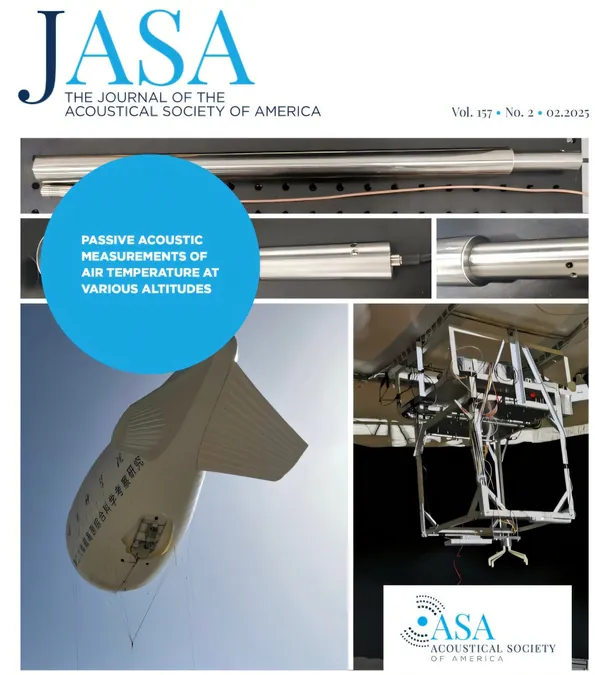
Revolutionary Acoustic Thermometry: Instant High-Altitude Temperature Readings That Could Change Meteorology Forever!
2025-04-02
Author: Ming
Revolutionary Acoustic Thermometry: Instant High-Altitude Temperature Readings That Could Change Meteorology Forever!
A groundbreaking research team from the Aerospace Information Research Institute of the Chinese Academy of Sciences has unveiled a cutting-edge acoustic thermometer capable of delivering real-time atmospheric temperature measurements at altitudes soaring up to 5,200 meters! Their innovative findings have been prominently featured as a cover article in The Journal of the Acoustical Society of America, stirring up excitement within scientific communities around the globe.
Importance of High-Altitude Temperature Monitoring
Why is this technology so crucial? High-altitude temperature monitoring is pivotal for accurate meteorological forecasts and vital climate change investigations. Traditional electronic thermometers often falter in reliability due to solar radiation interference and exhibit sluggish response times in thinner atmospheric layers. Infrared alternatives fall short as they are unsuitable for direct gas temperature measurements, leading scientists to seek a better solution.
Acoustic Thermometry: A Game-Changer
Enter acoustic thermometry, a game-changing method that measures atmospheric temperature with unmatched accuracy. Unlike previous methods that required precise distance controls between microphones and speakers to gauge sound speed related to temperature, the new approach developed by this research team utilizes a passive acoustic temperature measurement method grounding itself in the acoustic Fabry–Perot resonator (AFPR) concept.
The Innovative AFPR Design
The AFPR, ingeniously designed with a tubular acoustic waveguide and an electret condenser microphone (ECM), forms a unique acoustic FP cavity. This cavity is activated by ambient white noise, eliminating the need for an external sound source. The result? Rapid air temperature measurements that are not only accurate but also energy-efficient.
Remarkable Accuracy in Measurement
In controlled settings, the AFPR has shown an astonishing measurement error of less than 0.1°C when compared to conventional electronic thermometers, making it a highly reliable tool. The researchers have already demonstrated this technology across various high-altitude locations in China, including the picturesque areas of Kashgar and Hengdian, leveraging tethered aerostats for their experiments.
Real-Time Data Collection
During the ascent, stationary phases, and descent of these aerostats, the AFPR recorded frequency responses at 1.25-second intervals, enabling researchers to derive a linear connection between resonant frequencies and altitude. Astonishingly, results confirmed that the AFPR can accurately measure temperature fluctuations with a margin of error no larger than 0.5°C compared to electronic thermometers, showcasing staggering stability under diverse climatic conditions.
Ideal for UAV Deployment
Its simple architecture, impressive sensitivity, and minimal power consumption (with wireless data transmission under 2.5W) mark the AFPR as an ideal candidate for deployment on unmanned aerial vehicles (UAVs). The implications are enormous, from enhancing atmospheric science studies to pioneering remote sensing technology and revolutionizing environmental monitoring at high altitudes and into near-space realms.
The Future of Atmospheric Monitoring
Moreover, the AFPR can be integrated with technologies such as sound source localization and acoustic wind measurements, paving the way for a multifaceted high-altitude acoustic monitoring network. The future of meteorological and environmental research appears brighter than ever thanks to this innovative acoustic thermometer—stay tuned for further developments!


 Brasil (PT)
Brasil (PT)
 Canada (EN)
Canada (EN)
 Chile (ES)
Chile (ES)
 Česko (CS)
Česko (CS)
 대한민국 (KO)
대한민국 (KO)
 España (ES)
España (ES)
 France (FR)
France (FR)
 Hong Kong (EN)
Hong Kong (EN)
 Italia (IT)
Italia (IT)
 日本 (JA)
日本 (JA)
 Magyarország (HU)
Magyarország (HU)
 Norge (NO)
Norge (NO)
 Polska (PL)
Polska (PL)
 Schweiz (DE)
Schweiz (DE)
 Singapore (EN)
Singapore (EN)
 Sverige (SV)
Sverige (SV)
 Suomi (FI)
Suomi (FI)
 Türkiye (TR)
Türkiye (TR)
 الإمارات العربية المتحدة (AR)
الإمارات العربية المتحدة (AR)